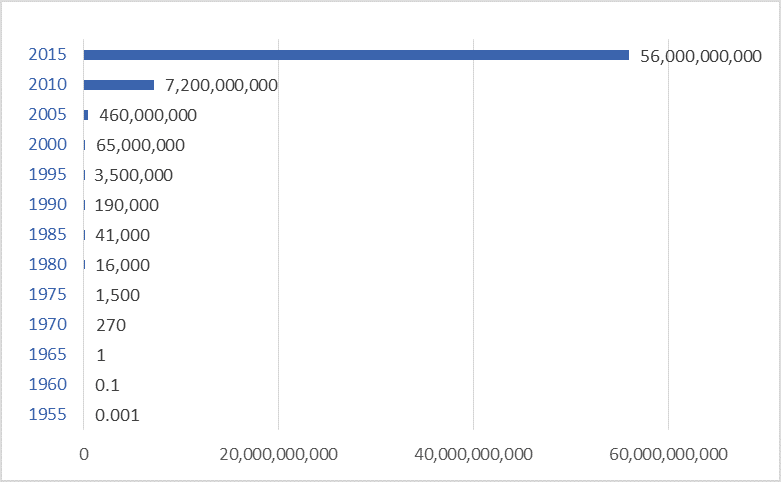Global production of transistors has surpassed 20 trillion per second—hundreds of quintillions per year. Transistors are the primary building blocks of modern electronic devices: computers, smartphones, TVs, radios, and other devices. Transistors use semiconductor materials to amplify (think transistor radios) or switch (think digital computers) electronic signals and electrical power. Transistors can be individual components, but are found in far greater numbers embedded in integrated circuits—in computer “chips.”
The graph above shows global production of transistors per year per person. Per capita values are used here to make the size of the numbers more manageable. In 1955, production was one transistor per 1,000 people—essentially zero. Radios and TVs in the mid-’50s used vacuum tubes rather than transistors and integrated circuits.
Just ten years later, in 1965, production had increased 1,000-fold, to one transistor per person per year. Transistor radios were gaining popularity in the 1960s. Each radio contained several transistors—often 5 to 10.
While production in 1965 was one transistor per person per year, by 1975 it was nearly 1,500 per person. Individual transistor components had been replaced by semiconductor computer chips, each containing thousands or millions of individual transistors.
The 1980s saw the proliferation of computers and home electronics. By 1985 global production of transistors had surpassed 40 thousand per person per year. By 2000 it was 65 million. Today it is 56 billion per person.
The world now produces more transistors in one second that it did in one year in 1980.
The global population could not afford to purchase, on average, 56 billion transistors per person per year if prices had remained at 1965 or 1985 levels. In the latter-1950s, a transistor radio with 5 transistors cost nearly $500 in today’s dollars. Now, for not much more money, you can buy an iPhone that contains hundreds of billions of transistors.
A pound of rice sells for approximately one dollar and contains about 25,000 grains. For that same dollar you can buy—as part of a memory stick or a phone—not 25,000 transistors, but billions. A transistor today is thousands of times cheaper than a grain of rice.
Much of the news about the world is negative: famine, genocide, fisheries collapse, climate change, extinctions, resource depletion. But we also need to acknowledge that our global hyper-civilization is truly wondrous. We have built human systems of nearly incomprehensible power and productivity. This is both their great strength and their great peril. Nonetheless, if we are to safeguard some version of this civilization into the future we must appreciate and value it, despite its profound flaws. We must take the time to understand it. And we must work together to reform it.
Graph sources: VLSI Research. Note that values are approximate and were derived, not directly from data, but from an existing graph. Thus, while overall trends and conclusions are robust, individual values for specific years are approximate.


This one really gave me pause. I have to admit I thought you had lost it, so I followed up and see you are right. Mind blowing stats. Now I wonder how can they make things that are so small? And the next thing is quantum computers.